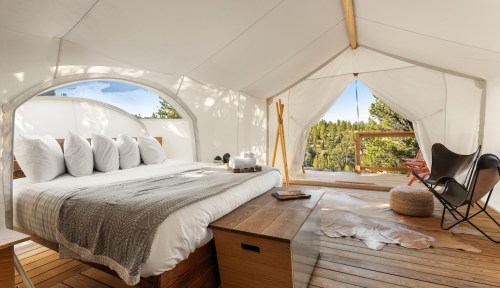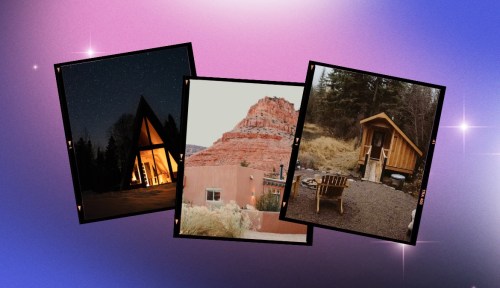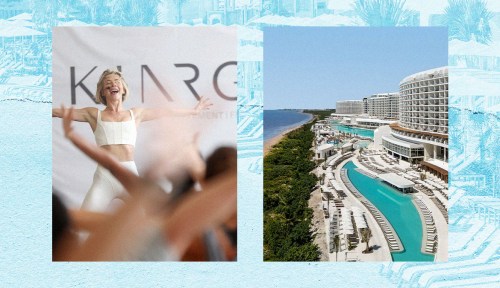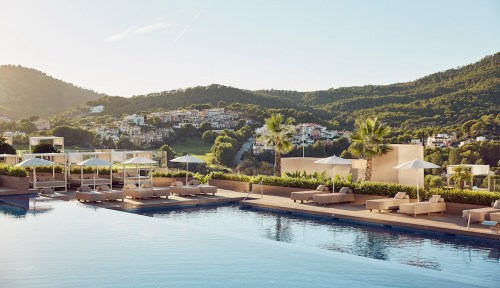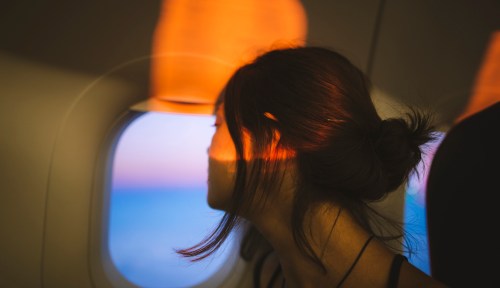Our editors independently select these products. Making a purchase through our links may earn Well+Good a commission
Blame my hometown of a beachy south Florida suburb, my summer-camp-less upbringing, or my anxiety-riddled preference for being in control of my surroundings, but I am decidedly not a “camping type.” In fact, I’ve never actually been camping; I simply enjoy hot showers and hot food and don’t enjoy the idea of sharing space with critters. But, glamping, on the other hand, has always intrigued me with its promise of delivering the virtues of camping alongside the creature comforts of a hotel. So when I had the chance to give it a try at Under Canvas’s newest and 10th location, near Bryce Canyon, in Utah, I was excited to learn whether I might be a happy glamper (if not a happy camper).
Experts in This Article
In keeping with the brand’s now well-established glamping style, the setup of the new Under Canvas Bryce Canyon consists of 47 safari-style lodging tents on elevated decks scattered across 750 acres of secluded mountain plains. The camp-glam tents are Instagram-worthy, with West Elm furnishings, like leather butterfly chairs and a bed so plush and well-blanketed, it could be in a five-star hotel.
The amenities were clearly right on par with my mental image of a glamping locale. But I realized soon after arriving with my boyfriend that, while our tent was beautifully prepared for us, it was us who weren’t necessarily ready for it, being that he is equally as camping-illiterate as I am, and we’d done approximately zero research on glamping ahead of our stay. While camping regulars might be shaking their heads, wondering what we might have needed to know before glamping, the truth is, glamping still has camping as its DNA. And though the properties classified as glamping vary widely (more on this below), a stay at many of them will still benefit from preparation, particularly for folks who haven’t ever camped.
What actually distinguishes glamping from camping?
At its core, glamping differentiates itself from camping by the fact that it doesn’t require you to provide or set up a place to sleep at night. But the “glam” in the name tends to create a lot of misconceptions about what else glamping really entails. “The portmanteau of glamour and camping is what trips people up from the get-go,” says Mike Howard, co-author of the glamping book, Comfortably Wild, and co-founder of travel site HoneyTrek.com, along with his wife, Anne Howard. “‘Glamour’ can make people think it’s for the Beverly Hills set, when really glamping is about making camping more interesting and approachable for people who wouldn’t normally take an outdoor vacation.”
“‘Glamour’ can make people think [glamping] is for the Beverly Hills set, when really glamping is about making camping more interesting and approachable.” —Mike Howard, co-founder of HoneyTrek.com
The proportion of “glam” to “camp” of any glamping site depends on the nature of the property. “Glamping has always rewarded the unique, and therefore, there are a lot of one-of-a-kind glamping operations out there,” says Ruben Martinez, founder of the American Glamping Association. “Yes, there are the ultra high-end camps that you can only visit by helicopter and that have a private chef, which will be at a higher price point, but there are also countless operations in remote locales with a handful of units that have a solid level of comfort, which are accessible and affordable.”
That said, all glamping locales generally include three main elements, according to Martinez: unique standalone structures (think: tents, domes, yurts, treehouses, or even trailers), a certain level of comfort, and, yes, close proximity to mother nature. While that element of comfort can turn a glamping unit into nearly the equivalent of a hotel room at the most luxurious of properties, or might involve extra on-site amenities—like the full-service restaurant in the lobby tent at all Under Canvas locations—it’s often not so extreme that you forget you’re really there to commune with nature.
Indeed, “glamping has, over the years, proven to be the gateway to the outdoors,” says Martinez. And the available nature activities near or on a glamping site are as essential to the definition of glamping as the tents or domes themselves. “Despite the misconception that glamping takes you away from nature, it actually gets you closer to nature by giving you more time to experience the outdoors and have fun,” says Toby O’Rourke, president and CEO of Kampgrounds of America. “Just think of all the miles you could hike, fish you could catch, meals you could make, and conversations you could have if you didn’t have to gear up, set up, or clean up [as you would while camping].”
In that way, glamping is experience-based travel at its heart, says Martinez: “People are not glamping to sit all day in their safari tent or dome.” In turn, the makeup of a glamping structure is typically designed to be comfortable enough for you to enjoy nature-based experiences in full, but not so amenities-driven that it negates the reality of your surroundings. “These properties are often in remote areas and are built to embrace the wilderness,” says Anne Howard, “so 24/7 electricity, air conditioning or heat, on-site food, en-suite bathrooms, and Wi-Fi are not givens.”
“In many ways, going back to the basics is the joy of glamping—but you’ll enjoy it more when you are prepared for what’s coming.” —Howard
Not to mention, the beauty of most glamping locations—the views, the silence, the natural features—also comes along with other elements of the great outdoors, like animals, insects, and poor or limited cell service, says Martinez. And largely, that’s the point: “In many ways, going back to the basics is the joy of glamping—but you’ll enjoy it more when you are prepared for what’s coming,” says Mike Howard.
5 things I would’ve liked to know before I went glamping, as someone who has never camped
Over the past few years amid the pandemic, the rise in interest in socially distant trips, coupled with the relative ease of glamping over camping has allowed glamping to really take off, particularly among folks who had never glamped or camped in the past. “Our annual 2022 North American Camping Report showed that 9.1 million households tried camping for the first time last year, and of those first-time campers, 50 percent experienced some type of glamping, whether in cabins, treehouses, safari tents, yurts, airstream trailers, or covered wagons,” says O’Rourke.
As a newly minted member of this growing subset, I found myself surprised by a few core elements of glamping that I simply hadn’t considered prior to arriving at Under Canvas Bryce Canyon. Below, find the key things that I would’ve liked to know ahead of diving into glamping, as a non-camper.
1. You should plan your daytime itinerary in advance
Under Canvas Bryce Canyon is equipped with many of the amenities that place it firmly on the luxury side of glamping, including not only the cozy-chic tent decor, but also the selection of hot breakfast and dinner items cooked on-site (including an un-skippable bison burger), the bottomless s’mores each evening, and the smattering of free nighttime activities, like guided stargazing and kid-friendly arts and crafts.
But it’s clear when you’re there that the point isn’t to spend too much time at camp during the day. The camp’s signature, like all Under Canvas locations, is its proximity to a national park—in this case, the otherworldly hoodoo-filled Bryce Canyon, which is just about a 15-minute drive away.
Leaving camp and doing something outdoors is a key part of glamping, which took my partner and me a moment to recognize.
Despite the fact that most campers would know, intuitively, that leaving camp and doing something outdoors is a key part of glamping, this took my partner and me a moment to recognize. And because we hadn’t processed this reality in advance, we had no idea what kinds of activities, hiking or otherwise, we wanted to do at Bryce Canyon while we were there (face-palm). By contrast, planning in advance will allow you to make the most of your time in nature.
Though we were lucky that Under Canvas Bryce Canyon has a selection of board games and cards in the lobby tent, as well as cornhole and lawn games outside, it’s also worth packing these kinds of things if you’re glamping somewhere with fewer amenities, says O’Rourke.
2. The elevation could have a big effect on the temperature…
As we weaved through and around mountains on our way to the camp, we could sense the temperature dropping to a degree we hadn’t anticipated, largely because we assumed that the desert locale we were visiting would be hot in August. What we hadn’t realized was that the high elevation of Bryce Canyon chills the air during the day and even more significantly at night. Which is all to say, the elevation of the place you’ll be visiting is an important thing to know before glamping, so you can pack layers accordingly.
3. …And you may not have great control over the temperature in your glamping structure
Perhaps the biggest commonality across all kinds of glamping structures is that they allow for maximum immersion in nature. Of course, that’s the point, but it also means they often aren’t the most well-insulated from the temperature outside, and they may not have air-conditioning or heat. In the case of Under Canvas Bryce Canyon, that reality was part of the rustic camping charm: Instead of being able to just click on the heat at night, we had to light a wood-burning stove.
I will spare you the details on how we struggled with this basic task, as I don’t suspect anyone who’s ever lit a fire before would have nearly as much trouble getting it going as we did. Even so, the heat of a fire—whether roaring or flickering—still doesn’t allow you much control over the temperature in a space. (Similarly, there’s a chance you’ll end up with a cold shower, as showers in cabins and tents may rely on propane tanks for heat, which, in our experience, don’t always heat things up so effectively.) And that’s a helpful thing to know while you’re packing (allow me to emphasize the importance of layers once more).
4. The cloud cover could impact your experience
While rain can put a damper on any kind of travel, it’s particularly problematic for glamping given that, like camping, you’re mostly outside. As a result, it’s doubly important to check the weather for rain and to understand general rain trends for the place you’re visiting at the time when you’re going. (Case in point: We had no idea that August is monsoon season in the Utah desert, and unsurprisingly, we were duly unprepared.) “To keep warm and dry, make sure you bring along rain boots, parkas, umbrellas, and plenty of extra socks,” says O’Rourke.
Because many glamping locales are located a good distance from cities, part of their remote appeal is in the potential for incredible stargazing—and the Under Canvas location in Bryce Canyon is no exception. Our tent was one of the property’s special “Stargazer” tents with a clear dome-like window over the bed, allowing the radiance of the stars above to serve as a natural nightlight. But because of ample cloud cover (again, rainy season), our visibility was ultimately limited. As a result, it would be helpful to know the average cloud cover of a glamping locale during different seasons and plan your trip accordingly, particularly if stargazing is high on your list.
5. You likely won’t have a closet or space to store valuables or food (beyond your car)
One last thing to know before glamping? Pack as lightly as you can, while still tossing in those essential layers. Tents, yurts, domes, and treehouses may not have actual doors with locks, nor will they likely have space to hang things up or lockable safes to secure any valuables.
Depending on the available food offerings at the place where you’re glamping, you may not need to bring much of any food or drinks at all. But if you do, you may be asked to keep them in your car, rather than bring them to your glamping quarters, as we were at Under Canvas, due to the risk of their attracting some unwelcome critters.
Sign Up for Our Daily Newsletter
Get all the latest in wellness, trends, food, fitness, beauty, and more delivered right to your inbox.
Got it, you've been added to our email list.
